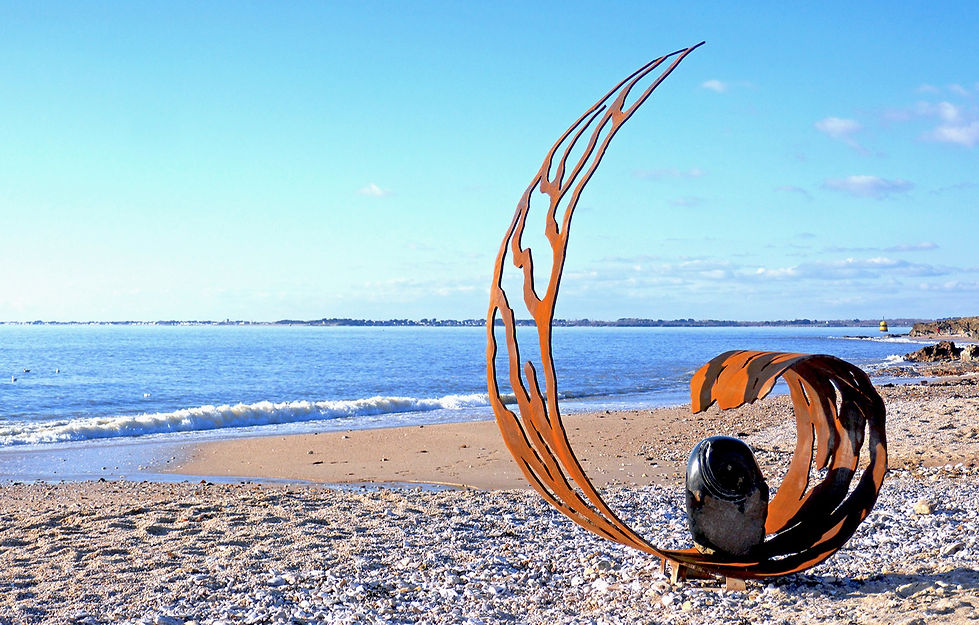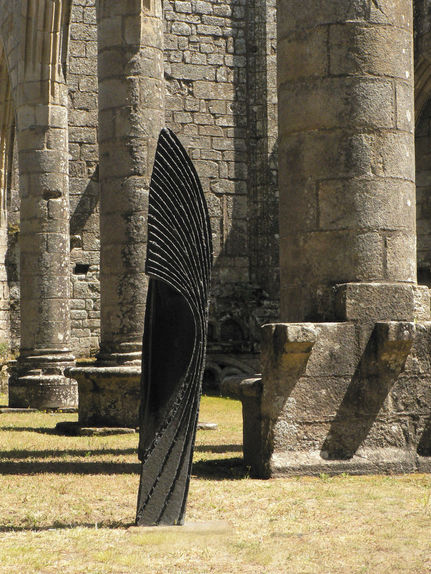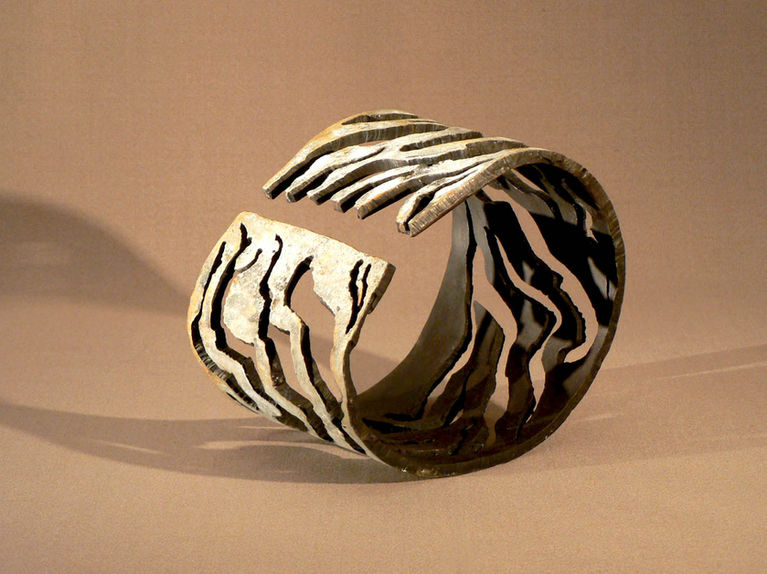Bruno Guihéneuf
Sculptures
Born in 1968, lives and work in Brittany and Sardinia.
A childhood of cross-influences from nature, the countryside, marshland and the see, of a grand-father painter and a father traveller, boatyards and granite quarries.
Studies from Applied Arts in Paris
Master Fine Arts RennesUniversity (Brittany)
Scenography for the theatre.
Between power lines and life lines.
" For a sculptor in our time the main problem is space.
Form and space do not only belong together,
in fact they are one.
Without form we wouldn't be conscious of space. "
Henry Moore
Every day watching the same tree
And every season seeing that everything changes,
every moment of life deepens what we control
and yet reinvents everything.
Watching the tree or the furrows of the earth,
inspired by the ripples on water
or by the movements of clouds,
drawing from the organic to sculpt this breath of life,
this tidal wave which carries us and offers us encounters and discoveries,
to calligraphy in steel these powerful and delicate waves
this is the essence of my Flux sculptures over the years.

At first sight it seems as if Bruno Guihéneuf doesn't easily uncover his own identity.
Indeed, in the range of visual arts he opens different registers: morphological very diversified sculptures, land art and environments used as a spiritual connection with the landscape. Moreover there are his so called papiers de granit, a unique graphical technique that confides the proper structure of the stone to the paper. These diverse artistic levels practised by Guihéneuf seem to develop totally independently from each other, nevertheless they share a common dimension and philosophical view.
Fluxis the common denominator in which the artist bundles a number of sculptures to scan the spatial order and at the same time he confirms that the primal stone cutting hasn't alienated from the world yet. Fluxis derived from the Latin fluere- meaning to flow or to stream. As a concept fluxis mainly used in mathematics or physics to define a process of throughput. Energy, time, space and surface are resolute factors in this process. Applying this concept on the work of Bruno Guihéneuf tells me that his creations unite all these elements and are mainly built on universal opposites : static- dynamic ; hard- fragile; cosmic - terrestrial ; light- dark .....
In the most simple form the greatest versatility and complexity is to be found.
This statement from the Romanian sculptor Constantin Brancusi can be a useful approach to the work of this French artist. In fact Guihéneuf is a formalist and a structuralist. By turning to specific kinds of stone like granite, marble or blue stone (occasionally combined with bronze, iron or wood) the artist by using simple forms can attain a headstrong sculptural language of images. The manually hacked, sawn and chiselled stones reveal a unity of planes, lines, grooves and points leading to an expressive form of the work of art, be it in the two dimensional treatment of the surface skin or in the three dimensional impact on the environment: a harmony that at the same time is aggressive and tender, powerful and fragile but also attracts and rejects.
The sculptures not only possess a mysterious expressivity, they also have a great deal of imaginative power. The simple forms, the organic roughness of the texture, the constructive aspect, the graphical rhythm of the lines and the dialogue between the different materials evoke various associations and interpretations: dolmen and menhirs from the stone age, weathered tree bark, enlarged fragments of skin folds, scratches, notches and documents of long gone cultures, geological segments of capricious sandrils drawn on the beach by the sea between ebb and flood.
The work of Guihéneuf is a constant plastic translation of a polarity moving between the core of the own identity, the I( man and artist) and the be, a whimsical flux, with everything chaotically turning around it, the unpredictable power of life lines and life powers.
Freddy Huylenbroeck | curator id+ Art Centre Hamme.
(English translation by Mark Suy)
Download the catalogue
Bruno Guiheneuf
Flux 2015

Introduced in 2010, "FLUX" is a set of works in 3 or 2 dimensions, characterized by streaks on the material. Stone sculptures are gouged with deep graphics, traps for shadow and mirrors for light; an alternation of raw, smooth or polished surfaces. Steel brings its flexibility, the graphics are liberated and opened out, like metallic calligraphy.
The search continues on paper, with imprints of mouldings and engravings: " papers of granite " and " papers of steel ".
These drawings engraved into matter, these "FLUX", suggest links with nature: the imagination perceives the bark of strong trees and the sap which irrigates them, the wrinkles and roguish folds of our skins, the circulation of blood, the currents of a river, the waves left on the sand by the sea, the furrows of the earth, promise of harvests, thousand-year-old geological foldings...
But these graphic networks have a higher aim: to transcend reality by expressing more profoundity, to construct abstraction. “FLUX” are lines of strength, of life; a visualization of the dynamic tensions of the universe.
"- It's pretty heavy.
- This isn't tofu we're dealing with. Stones tend to be heavy.
- But even for a stone it's heavy, Hoshino said.
(...)
Listen, every object's in flux. The earth, time, concepts, love, life, faith, justice, evil – they're all fluid and in transition. They don't stay in one place for ever. The whole universe is like some big FedEx box.
- Hm. "
Haruki Murakami "Kafka on the shore"
























